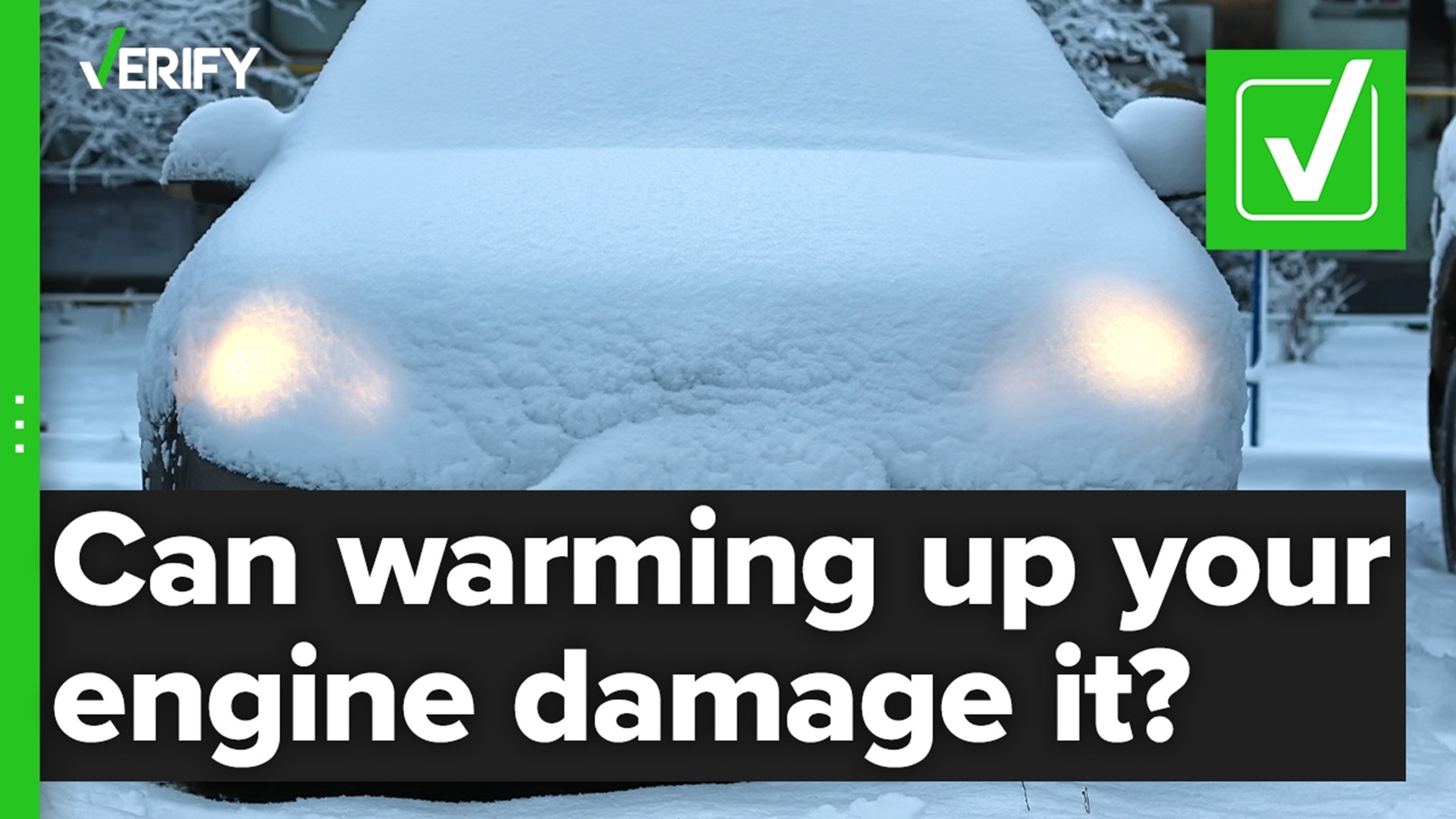As winter approaches, many people are starting to prepare their homes and vehicles for colder weather.
In frigid temperatures, it’s a common practice for many drivers to let their cars warm up for a while before hitting the road. Some vehicles even have a preset feature that lets drivers start their cars remotely.
But a VERIFY viewer asked if doing that can potentially hurt your car’s engine.
THE QUESTION
Can warming up your car before driving in cold weather damage the engine?
THE SOURCES
- Firestone Complete Auto Care
- Smart Motors Toyota in Madison, Wisconsin
- U.S. Department of Energy
- NAPA Auto Parts
- Chuck's Auto Repair in Seattle, Washington
- Utah Department of Environmental Quality
THE ANSWER
Yes, warming up your car before driving in cold weather could cause long-term damage to the engine. Most vehicles built after 1980 no longer need to warm up before driving, and experts say driving after 30 seconds to a minute after starting your car is a best practice.
WHAT WE FOUND
It’s true that warming up modern gas-powered vehicles before driving in cold weather could cause damage to the engine, according to the Utah Department of Environmental Quality, Chuck's Auto Repair, Firestone Complete Auto Care and Smart Motors Toyota, a dealership based in Madison, Wisconsin.
“If you're one of the many drivers who thinks it's important to turn on your car and let it sit for a bit before hitting the road in wintry weather, you could be doing your engine more harm than good,” Firestone says.
The Utah Department of Environmental Quality agrees.
"Excessive idling can actually damage your engine components, including cylinders, spark plugs, and exhaust systems," the Utah DEQ says. "Many components of the vehicle—including the wheel bearings, tires and suspension system—will warm up only when the vehicle is moving. You need to idle no more than 30 seconds to get the oil circulating through the engine."
Letting your car idle in cold temperatures can shorten the life of your engine by stripping away oil from the engine’s pistons and cylinders — two critical components that help your engine run, Stephen Ciatti, Ph.D., principal engineer for battery systems at PACCAR, told Business Insider in 2016.
Gas-powered cars need oil to keep their engines lubricated. When you start a car, an oil pump circulates the oil in less than a minute. But if you let your car idle to warm up the cabin, the oil can get stripped away.
Chuck's Auto Repair explains "Constantly letting a cold engine idle can actually be counterproductive because it gradually strips oil away from the engine’s pistons and cylinders... Here’s the problem: when the engine is cold, the gas may not evaporate completely as it combines with the air. For more recent cars with an electronic fuel injection, there are sensors that detect this and compensate by adding more gas to the mixture. When there is excess fuel in the chamber, some of it condenses onto the cylinder walls and strips away the lubricating oil. When the lubricating oil is gone, components like the cylinder liners and piston rings will wear prematurely."
“Less oil means more friction, more wear and tear, and a shorter life for your engine,” Firestone says.
While some people let their cars idle to warm up the interior, others may actually be trying to protect their engine because of outdated guidance.
Firestone and Smart Motors Toyota both say that most cars made before 1980 did need to “warm up” when it was cold out. This is because older model cars had carburetors that regulated the air-fuel mixture within the engine and could not accurately adjust the air-to-fuel ratio in cold weather.
“In cold temperatures, carburetors couldn't vaporize all the gasoline they let into the engine, so some of it would be left behind as a liquid rather than being burned off during combustion. In order to work properly, a carburetor needed to warm up or else you'd run the risk of stalling out,” Firestone says.
But times have changed since the 1980s. Nowadays, practically every car sold in the United States has an electric fuel injection system that helps maintain the air-fuel mixture needed for a combustion event, no matter the ambient temperature, according to Firestone and Smart Motors Toyota.
Instead of waiting for your car to warm up in the winter, most manufacturers recommend driving off gently after about 30 seconds because the engine warms up faster when the car is being driven, according to the U.S. Department of Energy.
“This means that your cold-day-driving routine should look something like this: bundle up, start the car, scrape the ice off the windows and mirrors, get in the car and get going!” Firestone says.
Just make sure you don’t accelerate too fast or rev your engine too much in the first few moments you start driving in the cold.
“This can add unwanted strain to your bearings and flood the combustion chamber with gas, which, in turn, will take miles off your engine’s life,” Smart Motors Toyota says.
For owners of electric vehicles, which don’t have traditional engines, the above information doesn’t apply, according to a blog post on NAPA Auto Parts’ website. Instead, NAPA advises EV owners to warm up their cars before they’re unplugged because it can help preserve the battery range.
“EVs have to draw on electricity to warm the interior. If you enter a car with a cold cabin and begin driving, the vehicle will need to take from its stored electricity to bring the inside air to a pleasant temperature. This will tax the EV’s battery and leave you with less driving range,” NAPA says.

